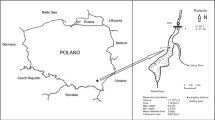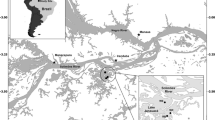Abstract
In the Amazon floodplain large areas of unvegetatedlake sediments are exposed to air during low water. Imeasured methane fluxes from exposed sediments of anAmazonian floodplain lake and assessed the regulatingfactors. Methane emission decreased from values between 10 and 40 μmol CH4 mminus 2 hminus 1to zero when the sediments were exposed to air. Meanfluxes were about 3.7 μmol CH4mminus 2 hminus 1. Fluxes were low compared tomeasurements taken from flooded habitats makingexposed lake sediments a negligible source ofatmospheric CH4. This was mainly due to the lackof ebullition which governs methane flux in theflooded phase. Methane oxidation at the sedimentsurface consumed up to 75% of the methane enteringthe oxidised zone. Compared with CO2 emissionmethane turnover was of minor importance for thecarbon budget of the sediments.
Similar content being viewed by others
References
Bartlett KB, Crill PM, Sebacher PM, Harriss RC, Wilson JO & Melack JM (1988) Methane flux from the central Amazon floodplain. J. Geophys. Res. 93: 1571–1582
Bartlett KB, Crill PM, Bonassi JA, Richey JE & Harris RC (1990) Methane flux from the Amazon river floodplain: Emissions during rising water, J. Geophys. Res. 95: 16773–16788
Crill P, Bartlett KB, Wilson JO, Sebacher DI, Melack JM, MacIntyre S, Lesack L & Smith-Morrill L (1988) Tropospheric methane from an Amazonian floodplain lake. J. Geophys. Res. 93(D2): 1564–1570
Deutsche Einheitsverfahren zur Wasser-, Abwasser-und Schlammuntersuchung (1984) DIN 38406, 6, Wiley-VCH
Devol A, Richey J, Forsberg B & Martinelli CA (1990) Seasonal dynamics in methane emissions from the Amazon floodplain to the troposphere. J. Geophys. Res. 95(D10): 16417–16426
Devol AH, Richey JE, Clark W & King SL (1988) Methane emission to the troposphere from the Amazon floodplain. J. Geophys. Res. 93(D2): 1583–1592
Frenzel P, Thebrath B & Conrad R (1990) Oxidation of methane in the oxic surface layer of a deep lake sediment (Lake Constance). FEMS Microbiol. Ecol. 73: 149–158
Henckel T & Conrad R (1998) Characterization of microbial NO production, N2O production and CH4 oxidation initiated by aeration of anoxic rice field soil. Biogeochemistry 40: 17–36
Houghton JJ, Meiro Filho LG, Callander BA, Harris N, Kattenberg A & Maskell K (1996) Climate Change 1995: Intergovernmental Panel on Climate Change. Cambridge University Press
Jugsujinda A & Patrick Jr WH (1996) Methane and water soluble iron production und controlled soil pH and redox conditions. Comm. Soil Sci. Plant Anal. 27(9+10): 2221–2227
Junk WJ (Ed) (1997) The Central Amazon Floodplain – Ecology of a Pulsing System, Ecological Studies 126. Springer, Berlin
Kern J (1995) Die Bedeutung der N2–Fixierung und der Denitrifikation für den Stickstoffhaushalt des amazonischen Ñberschwemmungssees Lago Camaleao. PhD Theses, Hamburg
Kern J & Darwich A (1997) Nitrogen turnover in the Varzea. In: Junk WJ (Ed) The central Amazon Floodplain – Ecology of a Pulsing System. Springer, Berlin
Kern J, Darwich A, Furch K & JunkWJ (1996) Seasonal denitrification in flooded and exposed sediments from the Amazon floodplain at Lago Camaleao. Microb. Ecol. 32: 47–57
King GM (1996) In Situ analyses of methane oxidation associated with roots and rhizomes of a Bur Reed, Sparganium eurycarpum in a Maine wetland. Appl. Env. Microb. 62(12): 4548–4555
King GM & Blackburn TH (1996) Controls of methane oxidation in sediments. Mitt. Int. Verein. Limnol. 25: 25–38
Lerman A (1988) Geochemical Processes, Water and Sediment Environment. Robert E. Krieger Publishing Company, Malabar (Florida)
L'air liquide (1976) Encyclopédie des Gaz. Elsevier Science Publishers, Amsterdam
Patrick WH, Gambrell RP & Faulkner SP (1996) Redox measurements of soils. In: Sparks DL (Ed) Methods of Soil Analysis Part 3 – Chemical Methods. Soil Science Society of America, Madison (WI)
Raich JW & Schlesinger WH (1992) The global carbon dioxide flux in soil respiration and its relationship to vegetation and climate. Tellus 44(B): 81–99
Stal LJ (1988) Nitrogen fixation in cyanobacterial mats. In: Packer L, Glazer AN (Eds) Methods in Enzymology, Vol 167. Academic Press, San Diego
Van Rees KCJ, Sudicky EA, Rao PSC & Reddy KR (1991) Evaluation of laboratory techniques for measuring diffusion coefficients in sediments. Environ. Sci. Technol. 25: 1605–1611
Wassmann R & Martius C (1997) Methane emissions from the Amazon floodplain. In: Junk WJ (Ed) The Central Amazon Floodplain. Springer, Berlin
Wassmann R & Thein UG (1996) Spatial and seasonal variation of methane emission from an Amazon floodplain lake. Mitt. Int. Ver. Limnol. 25: 179–189
Wassmann R, Thein UG, Whiticar MJ, Rennenberg H, Seiler W & Junk WJ (1992) Methane emission from the Amazon floodplain: Characterization of production and transport. Glob. Biogeochem. Cycles 6(1): 3–13
Rights and permissions
About this article
Cite this article
Koschorreck, M. Methane turnover in exposed sediments of an Amazon floodplain lake. Biogeochemistry 50, 195–206 (2000). https://doi.org/10.1023/A:1006326018597
Published:
Issue Date:
DOI: https://doi.org/10.1023/A:1006326018597




